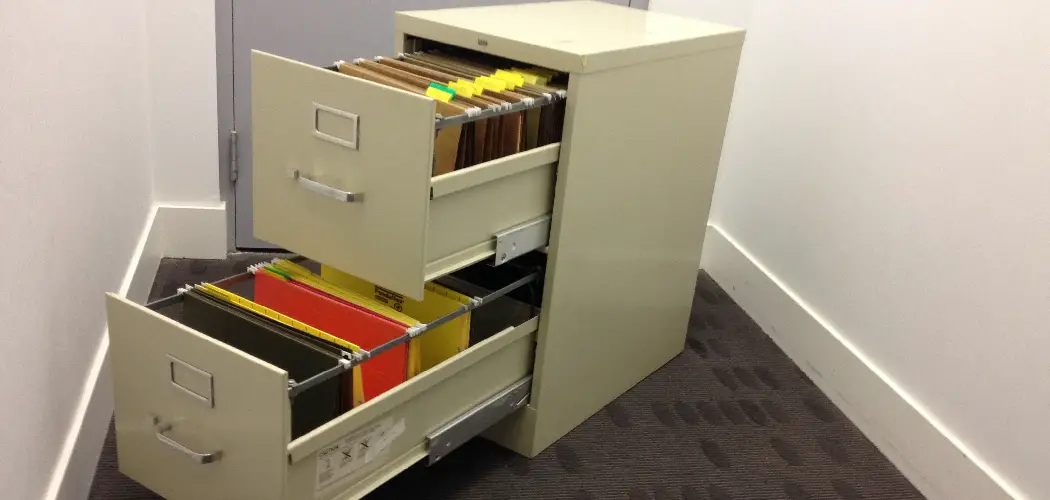Like most people, you have a lot of essential documents and files that need to be kept safe and organized. Instead of stuffing them in a drawer or under your bed, why not build a file cabinet? It’s a project that can be completed in just a few hours, and it will help keep your home office organized and tidy. In this article, we will show you how to build a File Cabinet. This is an easy project that can be completed in just a few hours. This file cabinet will help keep your home office organized and tidy. Let’s get started!
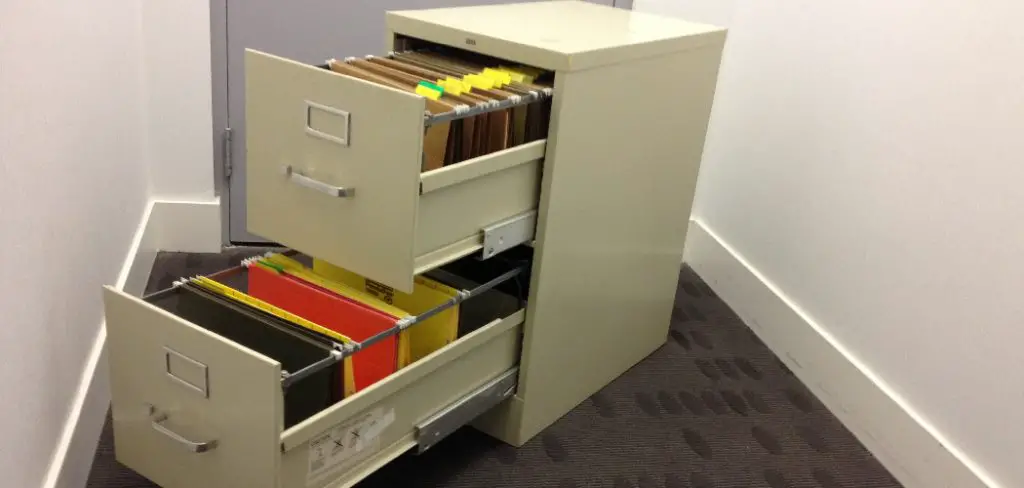
We all know that feeling when we stuff essential documents in a drawer or under the bed and then forget about them. However, building a file cabinet is an easy project that can be done in just a few hours, and it’s a great way to keep your home office organized. This article will show you how to make a file cabinet step by step.
Things You’ll Need:
- Measuring tape
- Level
- Drill
- 1/4 inch drill bit
- Jigsaw
- Wood glue
- Clamps
- Sandpaper
- Paint or stain
- Polyurethane (optional)
A Step by Step Guide on How to Build a File Cabinet
Building a file cabinet is a great way to organize and add extra storage to your home office. You can build a simple, basic file cabinet with just a few tools and lumber from your local hardware store. Or, you can get creative and add some unique details to make your file cabinet stand out. Whichever route you choose, building a file cabinet is a relatively easy project that anyone can do on the weekend.
Step 1: Before You Start
Before you start building your file cabinet, there are a few things you should take into consideration. First, decide what kind of wood you want to use. If you want a cheaper option, consider using particle board or MDF. However, remember that these materials are not as durable as solid wood and may not last as long.
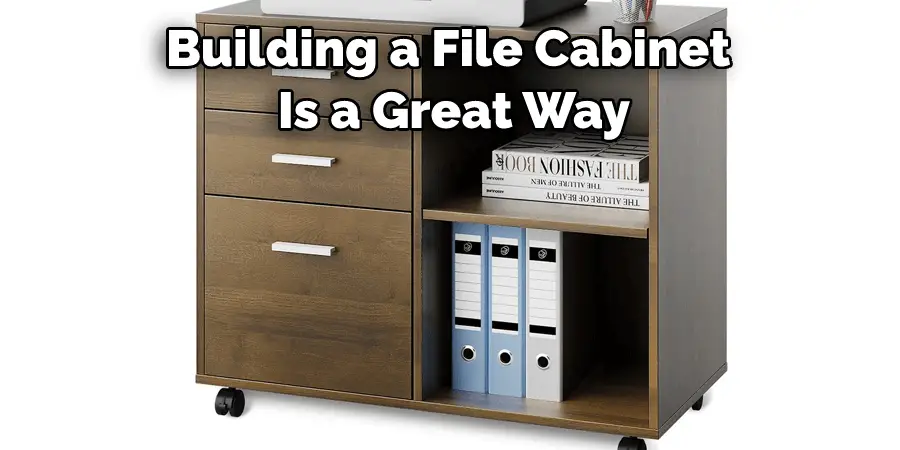
Solid wood is the way to go if you’re looking for a more durable option. But be aware that it is also more expensive. Another thing to consider is the type of finish you want on your file cabinet. A paint job will be the cheapest option, but it won’t be as durable as a stain or polyurethane finish.
Step 2: Determine What Type of Material You Want to Use
Once you’ve decided on the wood you want to use, it’s time to measure the space where your file cabinet will go. File cabinets come in all shapes and sizes, so make sure you know how much space you have to work with before you start building.
You’ll also need to determine how many drawers you want in your file cabinet. Of course, the more drawers you have, the more expensive the project will be. But if you have a lot of files, having more drawers may be worth the extra cost.
Step 3: Prepare the Workspace
Once you have all of your materials, it’s time to start building. Begin by setting up your workspace. If you’re working in a garage or basement, ensure the area is clean and well-lit.
If you’re working with power tools, read the instructions carefully before using them. And always wear safety goggles when using power tools.
Step 4: Measure and Cut the Wood
Now it’s time to start measuring and cutting the wood for your file cabinet. Begin by measuring the area where your file cabinet will go. Then, use a level to make sure the site is level.

Once you have the measurements, transfer them to the pieces of wood you’ll be using for the project. Then, use a saw to cut the wood to size. If you’re uncomfortable using a saw, you can always have the wood cut for you at a hardware store.
Step 5: Assemble the Drawers
Now that you have all your pieces of wood cut to size, it’s time to start assembling the drawers. Begin by drilling holes in each piece of wood for the drawer slides.
Once the holes are drilled, it’s time to start assembling the drawers. Start by applying wood glue to one side of each piece of wood. Then, fit the pieces of wood together and clamp them in place.
Let the glue dry for at least 24 hours before moving on to the next step.
Step 6: Attach the Drawer Slides
Once the glue has dried, it’s time to attach the drawer slides. Begin by attaching the slides to the top and bottom of each drawer. Make sure the slides are level even before you screw them into place.
If you’re using ball-bearing drawer slides, follow the manufacturer’s instructions carefully. These types of slides require special installation techniques.
Step 7: Finish the Cabinet
Once the drawer slides are installed, you can finish assembling your file cabinet. If you’re using particle board or MDF, you can screw the pieces of wood together. However, if you’re using solid wood, you may want to use dowels or biscuits to join the pieces together.
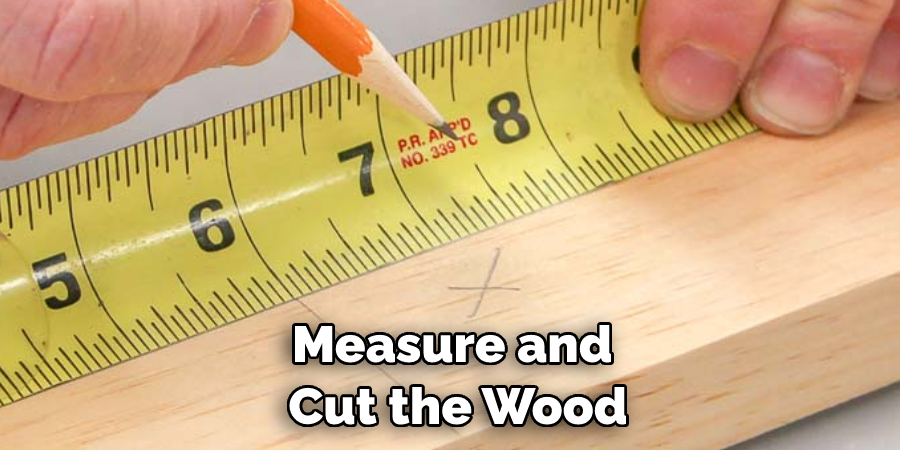
Once the cabinet is assembled, you can sand it down and apply a paint or stain finish. If you want an extra layer of protection, you can also apply a polyurethane finish. Let the finish dry completely before moving on to the next step.
Step 8: Install the Hardware
The final step is to install the hardware on your file cabinet. Begin by attaching the handles or knobs to the front of each drawer. Then, attach the caster wheels to the bottom of the cabinet.
If you’re using ball-bearing drawer slides, you may need to install special hardware to keep the drawers from falling out. But, again, consult the manufacturer’s instructions for more information. And that’s it! Your file cabinet is now complete.
Tips:
- Make sure to use high-quality materials. This will ensure that your file cabinet is durable and will last many years.
- Use a reliable set of plans. This will help to make the construction process much easier and faster.
- Be sure to follow all instructions carefully. This will help avoid any mistakes that could cause problems later on.
- If possible, ask someone else for help. Having an extra set of hands can be very helpful when building something as significant as a file cabinet.
Building a file cabinet can be a great way to add extra storage to your home office. With careful planning and attention to detail, you can build a beautiful and functional piece of furniture that will last for many years. By following these tips, you can ensure that your file cabinet turns out just the way you want it to.
What Type of Metal Are Filing Cabinets Made of?
The vast majority of filing cabinets are made from steel. This is because steel is incredibly strong and durable, meaning it can withstand a lot of wear and tear. It is also very affordable, making it a popular office furniture choice. Other metals are used to make filing cabinets, such as aluminum and wood, but these are not as common.
When choosing a filing cabinet, you should consider what type of metal it is made from. Steel is the most common and affordable option, but aluminum may be better if you are looking for a lighter-weight cabinet. Wood cabinets are less common but can add a touch of elegance to your office.
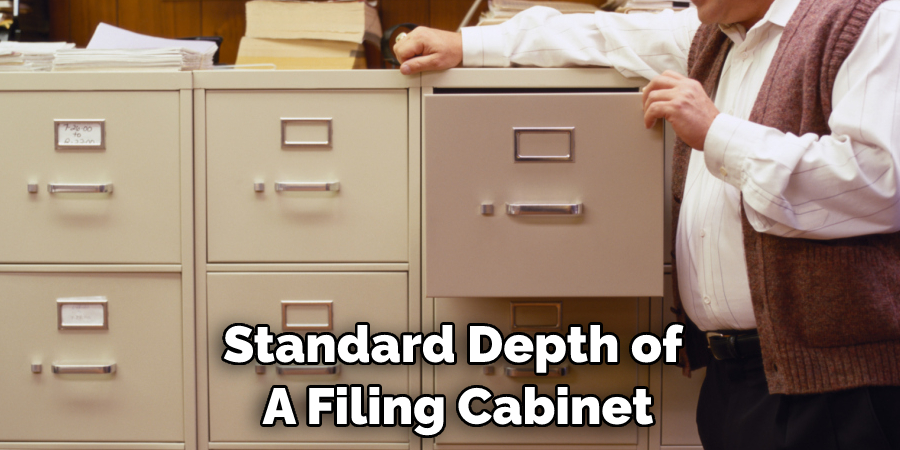
What Is the Standard Depth of a Filing Cabinet?
A filing cabinet is a piece of furniture used to store records or documents in a safe and organized manner. The standard depth of a filing cabinet is 21 inches. This depth allows the cabinet to hold letters and legal documents without too much space in a room. The cabinets are also typically equipped with several drawers, each of which can be used to store different types of documents.
For example, one drawer might be used for currently being worked on files, while another might be reserved for older files that are no longer needed daily. By having a designated place for all of your documents, you can help to keep your workspace tidy and organized.
How Big Should a File Drawer Be?
When planning the dimensions of your file cabinet, one crucial consideration is how big each drawer should be. You’ll need to decide whether you want letter- or legal-sized files, as this will affect the overall size of the drawer.
Each drawer should be at least 12″ wide and 24″ deep if you choose letter-size files. If you opt for legal-size files, each drawer should be at least 16″ wide and 27″ deep. Keep in mind that these are just minimums – you may want to go with a broader or deeper drawer if you have a lot of files or want more space to organize them.
Another factor to consider is the height of the cabinet itself. Standard file cabinets are usually about 30″ tall, but you can find more elevated options if you need more storage space. Just be sure the cabinet will fit under your desk or wherever you plan to put it.
Once you’ve decided on the size of your file cabinet, you’re ready to start building!
Conclusion:
Building a file cabinet is an easy way to organize your office and keep all your important documents in one place. By following these simple steps on how to build a file cabinet, you can have a functional and stylish piece of furniture that will help you stay organized and productive. Thanks for reading!

